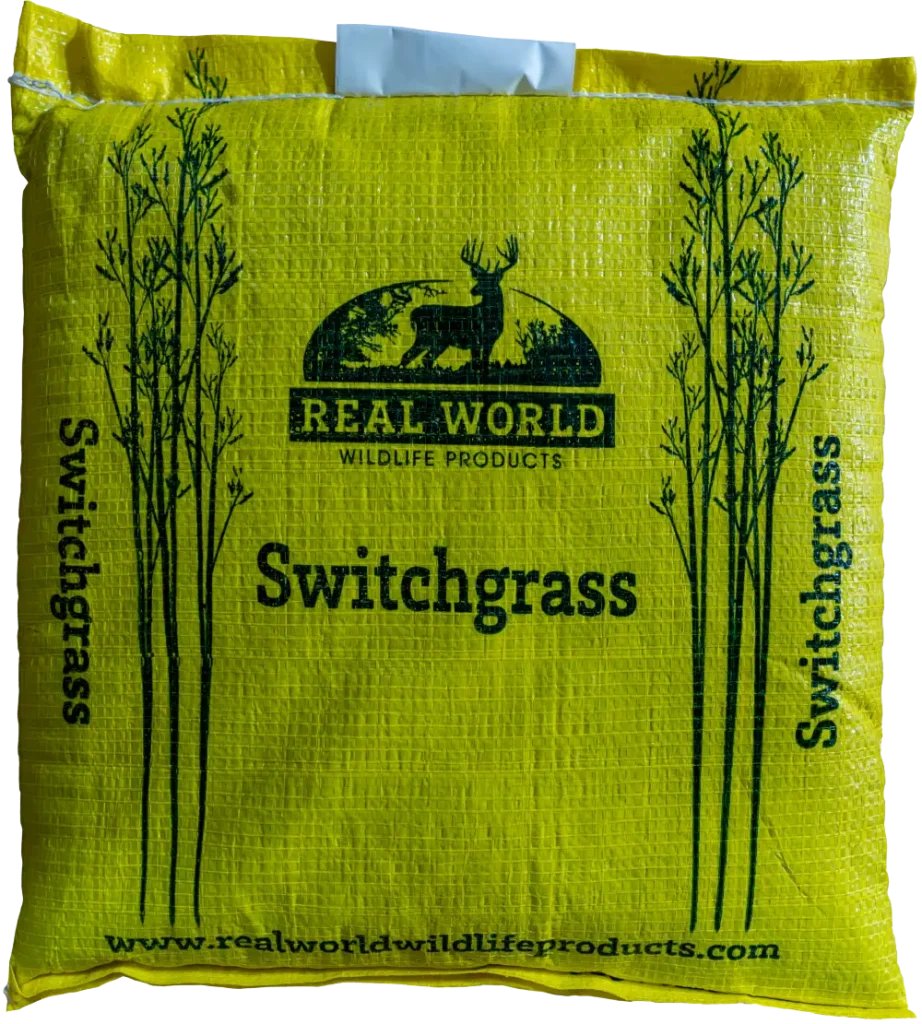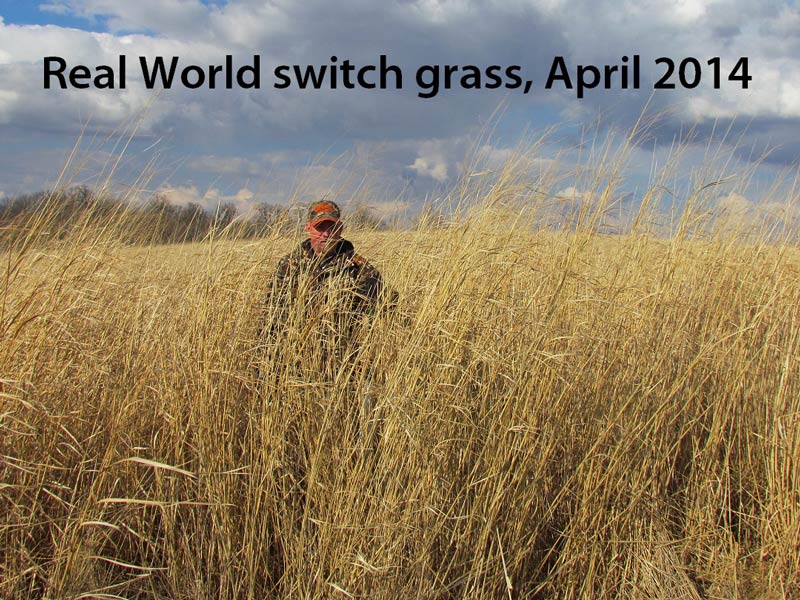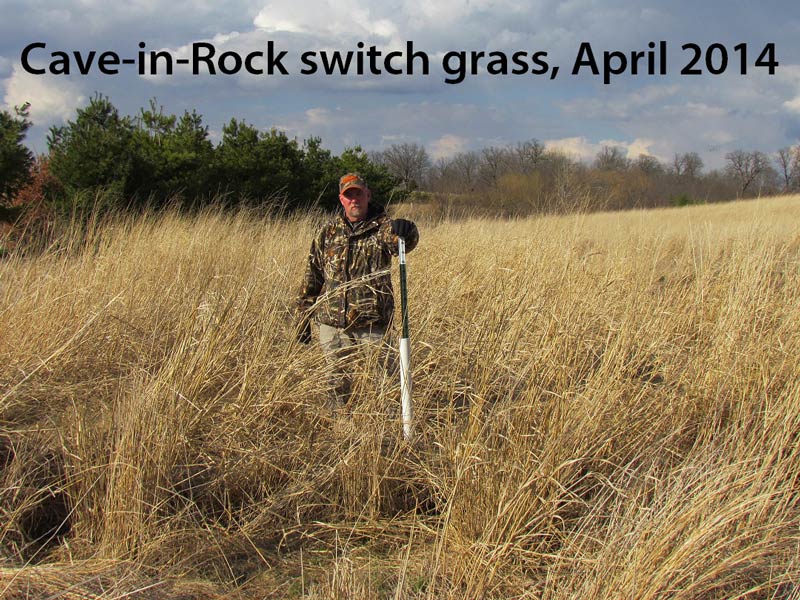
Full pallet quantities available.
To order full pallets, please contact your local dealer (click here for dealer locator) or call Real World’s corporate office at 217-994-3721.
Real World variety switch grass is the same switch grass that we use in our Bedding-In-A-Bag. In our side by side tests this switch grass stood better than any other variety we tested including the popular Cave-In-Rock variety. Our Real World Switch Grass will get 7’-8’ tall. Don’t take our word for it, Dare to Compare!


These 2 photos show the difference between Real World switchgrass and the popular Cave-in-Rock variety of switchgrass. There is no “trick photography” here; these photos were taken the same day just a few feet apart in side-by-side test-plots. Note that these photos were taken in early spring after the grasses had been through the entire winter. Clearly the Real World switchgrass has better standability and offers better bedding cover for wildlife.
Planting straight switch grass instead of “Bedding in a Bag” is the best option on wetter sites such as creek or river bottoms where other grasses do not do as well. Many of our customers also use Real World switch grass to create screening cover along food plots or access routes to their stands.
Note – When planting warm-season native grasses for bedding cover always remember that bigger is better when it comes to plot size. Deer are much more likely to bed in bigger plots of these grasses than smaller ones. On our own properties we never plant plots of these grasses smaller than 5 acres.
Switchgrass Planting Instructions
Please read these instructions completely before starting your switchgrass planting project! It could save you a lot of time, money and disappointment.
Ground Preparation – Your planting site should be TOTALLY free of any growing or established plants. Frost-seeding or no-till drilling can be done with no ground prep on sites free of other live vegetation, particularly cool season grasses which will out-compete switchgrass and hinder its establishment. The only way to get rid of established grasses is with herbicide. If you try just burning, tilling or mowing a site where grasses are growing, your switchgrass project is doomed to fail.
Seeding rate – Real World Switchgrass should be planted at rates of 4-5# per acre. More is not better! Higher seeding rates can result in crowding where the grasses are stunted and will not grow as tall. Real World recommends that you plant our switchgrass at a rate of 4# per acre. It is often difficult to spread 4# of seed over an entire acre so to make this process easier you can mix the seed with pelletized lime to get more material to spread.
Planting methods – The best way to plant switchgrass is with a no-till drill in mid to late spring at a depth of 1/8” – 1/4”. Another less desirable option is by frost-seeding in the late winter or early spring. This simply involves broadcasting the seed onto ground (even frozen ground or snow-covered ground) that has either been prepared the previous fall or is bare or in a crop residue such as soybean stubble or cornstalks. When frost-seeding it is important that the site be totally free of established grasses.
A third option for planting switchgrass is broadcasting the seed onto freshly prepared soil and then either culti-packing or lightly dragging. The seed should be no more than 1/4” deep.
Stratification – Stratification is a process of freezing and thawing to loosen the hard seed-coat that some seeds must go through before they will germinate. Switchgrass is one of those seeds. Frost-seeding generally results in good stratification which results in good germination. If you are using another planting method, it is recommended to put your switchgrass seed in a freezer for a week at a time with a week of storage at warmer temperatures in between. This series of freeze/thaw cycles will stratify the seed and result in improved germination rates. Note – Real World Switchgrass can be planted without stratification with good results.
Herbicide – Atrazine and Simazine are pre-emergent herbicides that you can spray onto plots to be planted in switchgrass. This will prevent a lot of weeds from ever germinating. Switchgrass is tolerant to atrazine/simazine and thus the seed will not be affected. Simazine can be purchased from Real World Wildlife Products without a special pesticide applicators license.
Once your switchgrass plot has vegetation growth of 12-18” (both weeds and switchgrass) it can be sprayed with 2,4-D herbicide. 2,4-D will kill broadleaf weeds only without harming any grasses.
Note – Always follow labeled rates and instructions when using any herbicide.
Be Patient! All warm-season native grasses can be slow to germinate and establish. It is very common to not be able to see any growth at all for the first 45 days or so after planting and it often takes 3 years to get a good stand although it can happen in less time under ideal conditions. If your switchgrass plot looks poor the first year do not give up but be patient.
Maintenance – The very best thing you can do for any warm-season native-grass planting is burn it in the spring. There is no good substitute for burning. If you won’t or can’t burn your switchgrass plot it will never be as good as it could be. Ideally you should burn your switchgrass every other year starting the second spring after planting.
Keep These Instructions!!!! And refer back to them when you have questions.